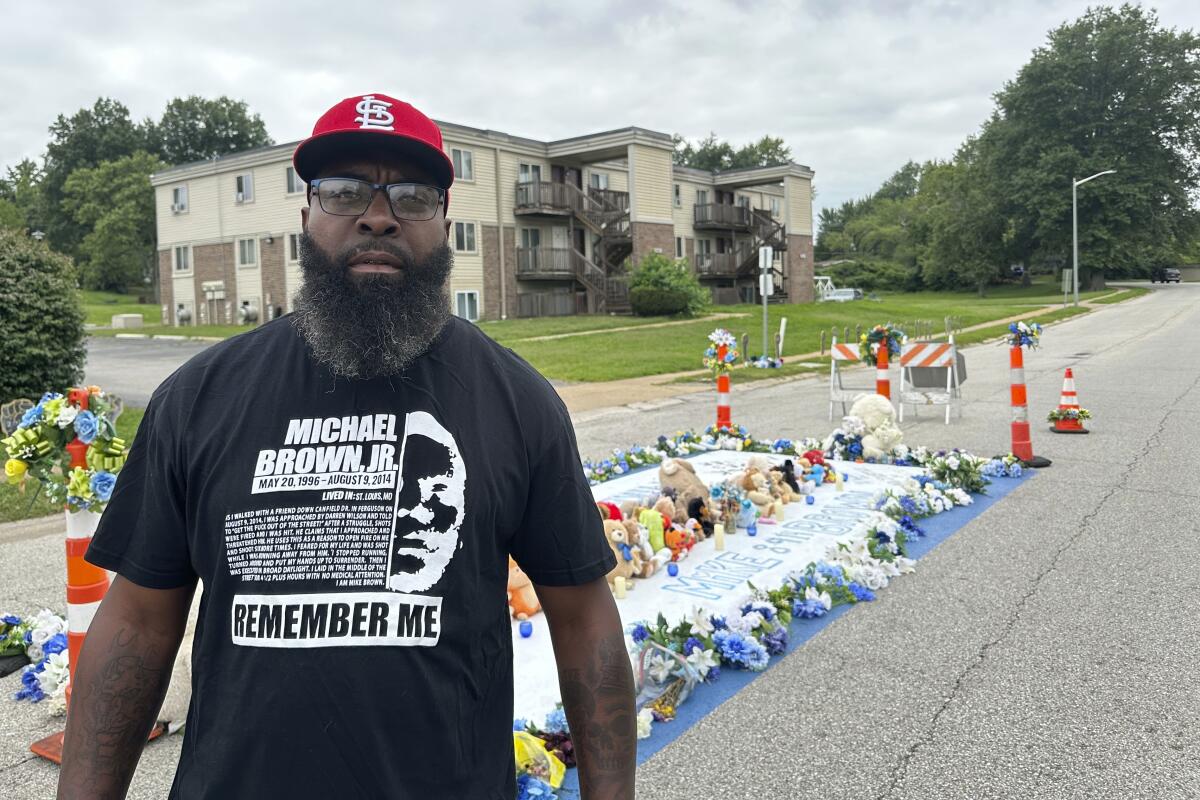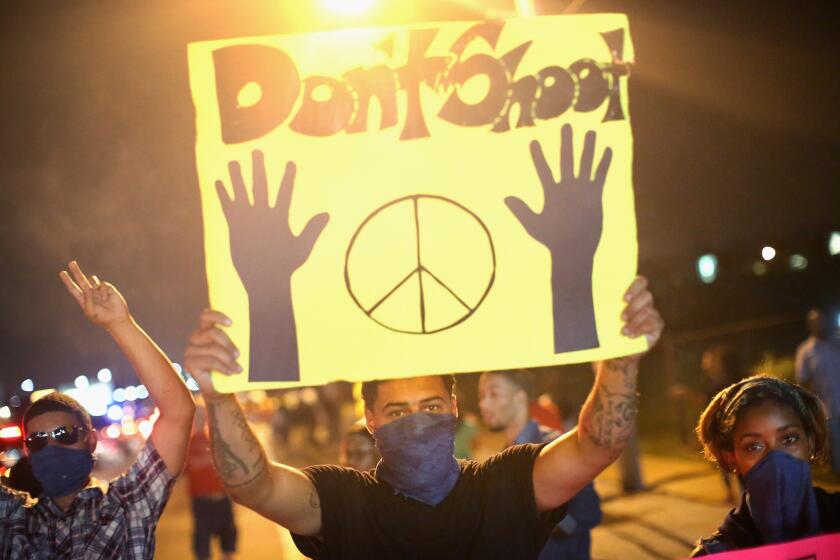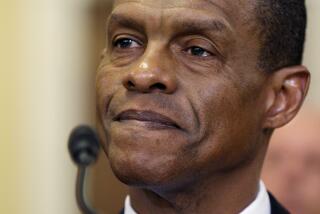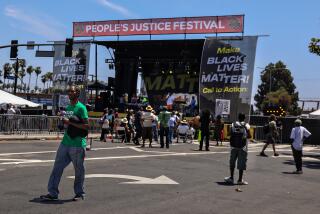Ferguson marks 10 years since Michael Brown’s death. There’s been progress, but challenges remain

- Share via
FERGUSON, Mo. — Michael Brown once told his father the “world is going to know my name,” words Michael Brown Sr. still takes to heart.
Friday marked 10 years since the 18-year-old was killed by a police officer in Ferguson, Mo., turning the St. Louis suburb into the focal point of the national reckoning with the historically tense relationship between U.S. law enforcement and Black people.
The elder Brown now devotes his time to the Michael Brown Sr. Chosen for Change Organization, a foundation that helps fathers, mothers and children come to grips with tragedy in their lives. It’s a legacy he feels obligated to pass on under the name he shares with his son.
“He was going to shake the world,” Brown said of his son. “So, I guess that’s what we’re doing. He’s still doing the work from the grave.”
Activists marked the anniversary with a march through Ferguson, chanting Brown’s name and singing. When the march reached a memorial of stuffed animals, blue roses, lilies and candles, Brown’s father released butterflies from a box.
“Justice ain’t nothing but what love looks like in public,” independent presidential candidate, professor and author Cornel West said at the memorial. “We shall never, ever forget the joy and the love of our dear brother Michael Brown Jr.”
Brown’s killing catalyzed massive change in Ferguson. In 2014, every city leader was white in the majority-Black city. Today, the mayor, police chief, city attorney and other leaders are Black. The mostly white police force of a decade ago now has more Black officers than white ones.
The municipal court system that once brought in millions of dollars in fines and fees, often for relatively minor traffic offenses — paid mostly by poor residents — now collects only a fraction of that.
But problems persist. The current mayor and former mayor acknowledge that race still divides the community of 18,000 residents. Some are concerned that police, wary of criticism, aren’t enforcing traffic laws, since serious and sometimes fatal wrecks are common.
What happened Aug. 9, 2014
Michael Brown and a friend were walking along Canfield Drive when Officer Darren Wilson drove up and told them to get on the sidewalk. A fight ensued and, fearing for his life, Brown ran.
Though Brown was unarmed, Wilson described Brown as menacing at 6-foot-4 and claimed he came at the officer. But some nearby residents said Brown had his hands up in surrender when Wilson shot him.
Activist Zaki Baruti recalled the horror and fear that other Black residents felt after Brown’s death.
“There was a sense of shock, not knowing what to do,” Baruti said.
To understand Michael Brown and why his shooting has unleashed such anger here, go to the place where he lived and died.
James Knowles III, who was mayor in 2014, believes that the widespread anger about Brown’s death was driven by several factors.
Social media allowed information — and sometimes misinformation — to spread quickly, he said. Neighbors were incensed when Brown’s body was left in the street for more than four hours on that hot August afternoon.
The night after Brown’s death, thousands of protesters marched along West Florissant Avenue, near Canfield. A QuikTrip convenience store was torched, and goods were stolen from many businesses.
Months of fierce protest, at which demonstrators were tear-gassed, soon thrust the city into the national spotlight.
When St. Louis County Prosecuting Atty. Bob McCulloch announced in November 2014 that Wilson would not be charged, protests erupted again.
Police in Ferguson, Mo., delivered an “ineffective response” to the riots that followed the fatal police shooting of Michael Brown last year, did not understand the gravity of the public anger and fired “Stingerballs, PepperBalls, bean bag rounds and baton rounds” in failed attempts to quell the escalating disturbance, the U.S.
What changed in Ferguson
In 2015, an investigation by the U.S. Department of Justice also found no grounds to prosecute Wilson. But the report gave a scathing indictment of the Police Department — raising significant concerns about how officers treated Black residents, and about a court system that created a cycle of debt for many residents. A year later, the city agreed to a federal consent decree requiring sweeping changes. The decree is ongoing.
In 2016, Missouri lawmakers passed a law limiting the amount of revenue that municipal courts could collect from fines. In 2013, Ferguson collected $2 million in court fines and fees, according to data from ArchCity Defenders, a St. Louis-based civil rights law firm. In 2023, the city collected about $97,000.
Some companies and organizations stepped in to create jobs and opportunities after the unrest in Ferguson, which brought more awareness of economic challenges in the community.
‘A new look’ for policing
Troy Doyle was a veteran St. Louis County police officer who worked in Ferguson during the 2014 protests. Nearly a decade later in April 2023, Doyle, who is Black, was hired as Ferguson’s chief — the latest of several hires since Tom Jackson resigned in 2015, following the Justice Department report.
In 2014, Ferguson had about 50 white officers and just three Black officers. Today, 22 of Ferguson’s 41 officers are Black. Only four officers who were on staff in 2014 remain. Officers today are trained on implicit bias, de-escalation and community relationship-building.
Doyle said he has worked hard to change the mind set of officers who might be resistant to the court-imposed requirements. He even replaced uniforms and changed the look of patches, badges and police cars, worried that the old look was “triggering” for many residents.
“For some people who live in the community, every time they saw a Ferguson police officer, it brought back memories,” Doyle said. “I wanted to give us a new look, but part of that new look was to let people know it was a new police department.”
Michael Brown Sr. said he’s noticed the change.
“It’s a weight that’s been lifted up off the Black community in terms of stop-and-frisk and assessing tickets,” Brown said. “There’s a lot of things that still need to get done. Those things are not promised overnight. It’s a process.”
Amnesty International has sent monitors to the scene.
Problems persist
After serving three terms as mayor, Knowles left office in 2020 because of term limits.
Knowles frequently meets for breakfast with Ella Jones, who was elected as Ferguson’s first Black mayor in 2020 and reelected last year. They both acknowledge that race relations remain a struggle.
“The city is turning back,” Jones told the St. Louis Post-Dispatch. “It really is. Everything here is along racial lines.” The City Council has four white members and three Black members, and little gets done, she lamented.
Knowles sees that, too. He also worries about public safety as many drivers — aware police are less likely to pull them over — flaunt traffic laws. He also believes too much money is being spent on the consent decree — money he believes would be better spent on fixing streets, hiring more officers and restoring crumbling parks.
The legacy of Black Lives Matter
Karla Scott, communications professor and former African American studies program director at St. Louis University, said Ferguson will survive because its residents are resilient and proud of their community.
“But I think it will always be the sort of epicenter for many of us who can remember where we were when we heard the news, or for people who went out there to stand in solidarity, to march in solidarity, to make their voices heard,” Scott said. “It will always be that place where the Black Lives Matter movement really took off.”
Salter writes for the Associated Press.
More to Read
Sign up for Essential California
The most important California stories and recommendations in your inbox every morning.
You may occasionally receive promotional content from the Los Angeles Times.













